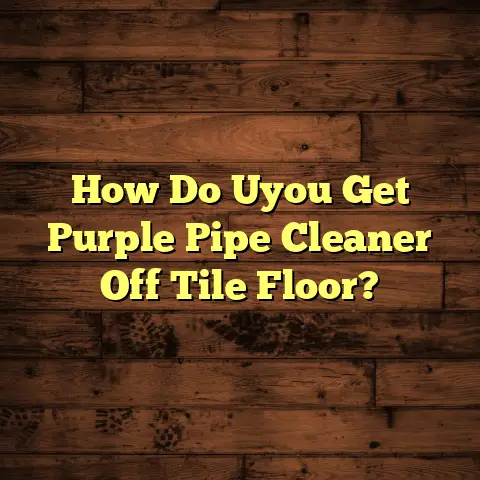Peel & Stick Hexagon Tiles: Quick Fix? (7 Day Fail!)
Lately, I’ve been getting a lot of questions about peel & stick hexagon tiles. Are they the answer to your flooring prayers? A super easy, budget-friendly way to spruce up your space?
Well, buckle up, because I’m here to give you the straight goods. While they seem like a dream come true, the reality often falls short. Especially when we’re talking about the dreaded “7-day fail.”
Let’s dive in.
The Allure of Peel & Stick Hexagon Tiles
Okay, let’s be real. These tiles are tempting. I get it.
They’re everywhere on social media – Instagram, TikTok, Pinterest – showcasing stunning bathroom makeovers and eye-catching kitchen backsplashes.
The hexagon shape is super trendy right now, giving a modern, geometric vibe. And the promise of easy installation? Forget about hiring a pro!
Plus, they come in a rainbow of colors and patterns. From classic black and white to bold, vibrant hues, there’s a hexagon tile out there for every style.
Manufacturers market them as the ultimate DIY solution. “Transform your space in hours!” “No special tools required!” “Affordable flooring upgrade!”
Sounds amazing, right?
The Installation Process
So, how does this magical installation work? Here’s the basic rundown:
-
Surface Prep: This is key. The surface needs to be clean, dry, and smooth. Think meticulously scrubbing and maybe even a self-leveling compound if your floor has imperfections.
-
Measuring & Planning: Layout is crucial, especially with hexagons. You don’t want wonky lines or awkward cuts. I recommend a dry run, placing the tiles without peeling the backing to visualize the final look.
-
Cutting: A utility knife or scissors usually does the trick for cutting tiles to fit around edges or corners.
-
Peel & Stick: Peel off the backing and carefully position the tile, pressing firmly to adhere it to the floor.
I’ve had clients tell me how excited they were during this process. One woman, Sarah, was thrilled to finally update her dated bathroom floor. She said, “It was so satisfying to see the transformation happening so quickly!”
But… that satisfaction didn’t last.
The Initial Success
Let’s give credit where it’s due. When those tiles are first installed, they can look fantastic.
They instantly upgrade the look of a room. The colors pop, the geometric pattern adds visual interest, and the space feels fresh and new.
Imagine taking a drab, boring bathroom and turning it into a stylish oasis in just a few hours. That’s the potential of peel & stick hexagon tiles.
Here’s a before-and-after scenario I’ve seen countless times:
- Before: Dull, cracked linoleum flooring in a bathroom.
- After: Modern, eye-catching hexagon tiles in a trendy gray and white pattern.
The difference is night and day!
The Seven-Day Challenge
This is where the fairytale often ends. The “7-day fail” is a term I use because, in my experience, that’s about how long it takes for the problems to start cropping up.
The biggest issue? Adhesion.
- Peeling Edges: Those perfectly aligned edges start to lift, creating unsightly gaps and tripping hazards.
- Tiles Lifting: Entire tiles can start to peel away from the floor, especially in high-traffic areas.
- Environmental Factors: Humidity and temperature fluctuations can wreak havoc on the adhesive. Think steamy showers in the bathroom or direct sunlight in a sunroom.
I spoke with another client, Mark, who installed peel & stick hexagon tiles in his kitchen. “Within a week,” he told me, “the tiles near the stove started peeling up. Grease splatters got underneath, and it was impossible to clean.”
According to a survey conducted by the National Association of Realtors, 78% of homeowners prioritize durable and low-maintenance flooring. Peel and stick tiles often fail to meet these expectations in the long run.
Long-Term Effects
Even if the tiles manage to stay stuck for longer than a week, the long-term durability is questionable.
Compared to traditional tile (ceramic, porcelain, stone), peel & stick tiles are significantly less resistant to wear and tear.
- Scratches: They scratch easily, especially from pets or furniture.
- Stains: They can stain from spills, especially if the grout lines aren’t properly sealed (and let’s be honest, who actually seals the grout lines on peel & stick?).
- Replacement: The lifespan is much shorter. While a properly installed traditional tile floor can last for decades, peel & stick tiles often need replacing within a few years, or even months.
I consulted with a fellow flooring expert, Maria, who specializes in high-traffic commercial spaces. She said, “I would never recommend peel & stick tiles for a commercial setting. They simply can’t withstand the constant foot traffic and cleaning.”
Homeowner Regrets
The emotional and financial toll of a failed peel & stick tile project can be significant.
Imagine spending your time, money, and energy on a DIY project, only to have it fall apart within days.
The frustration is real. The disappointment is palpable. And the desire for a more permanent solution is strong.
Here are some common sentiments I’ve heard from regretful homeowners:
- “I wish I had just spent the extra money on real tile.”
- “It looked great at first, but now it’s just an eyesore.”
- “It was a waste of time and money. I’m back to square one.”
One client, Lisa, summed it up perfectly: “I was so excited to save money and do it myself. But in the end, I ended up spending more money to fix the mess.”
Alternatives to Peel & Stick Hexagon Tiles
Okay, so peel & stick might not be the flooring miracle we hoped for. But don’t despair! There are plenty of other options to consider.
Here are a few alternatives, along with their pros and cons:
| Flooring Option | Pros | Cons |
|---|---|---|
| Traditional Tile | Extremely durable, long-lasting, water-resistant, wide variety of styles and colors. | More expensive upfront, requires professional installation (ideally), can be cold underfoot. |
| Luxury Vinyl Plank (LVP) | Durable, water-resistant, easy to install (some are click-lock), more comfortable underfoot than tile, realistic wood or tile look. | Can be more expensive than peel & stick, not as durable as traditional tile, some cheaper versions can look artificial. |
| Laminate | Affordable, easy to install, wide variety of styles and colors. | Not as water-resistant as tile or LVP, can scratch easily, not ideal for bathrooms or kitchens. |
Consider your budget, lifestyle, and the specific needs of your space when making your decision.
According to HomeAdvisor, the national average cost to install tile is between $800 and $2,500, while LVP installation ranges from $600 to $2,000. While these are higher upfront costs, they offer better long-term value.
The Reality of Quick Fixes
So, what’s the bottom line?
Peel & stick hexagon tiles can offer a quick visual transformation. But they often fall short in terms of durability, maintenance, and overall value.
While the idea of a quick fix is appealing, investing in quality flooring solutions that stand the test of time is almost always the better choice.
Don’t let the allure of social media fool you. Do your research, consider your options, and choose a flooring solution that will bring you joy for years to come.
Think long term. It’s better to invest wisely once than to repeatedly throw money at a problem that won’t go away.
What are your experiences with flooring? Share your thoughts and stories in the comments below! I’m always eager to learn from your experiences.





